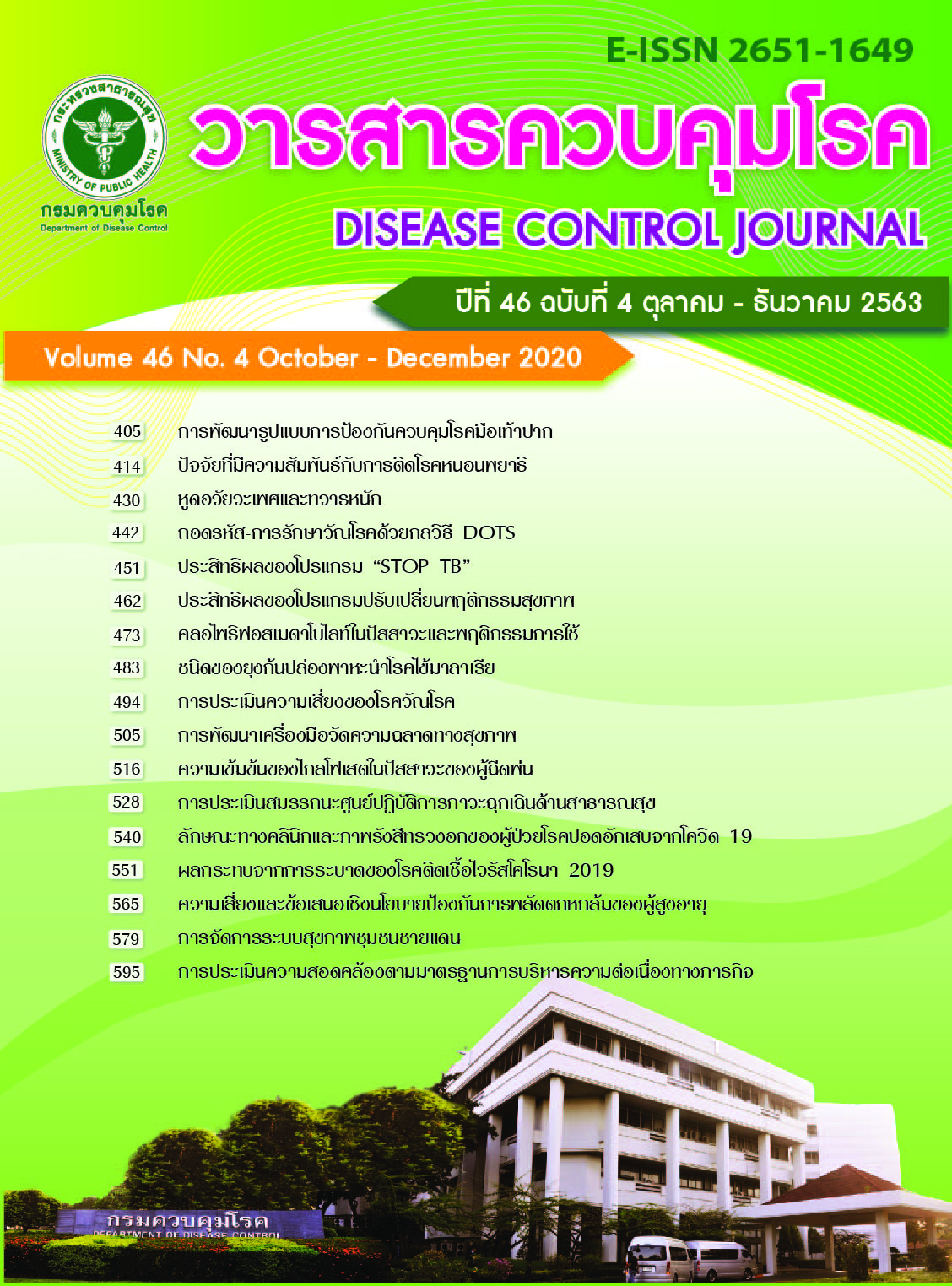The factors associated with helminthic infection among people at Bo Kluea District, Nan Province
DOI:
https://doi.org/10.14456/dcj.2020.39Keywords:
helminthiasis, risk behaviors, Opisthorchis viverriniAbstract
This cross-sectional study aimed to determine the situation of helminthiasis and the risk factors correlated to parasitic infection among people in Bo Kluea district, Nan province. By applying the research methods developed by the Department of Diseases Control, Modified Kato Katz technique for stool examination and questionnaire for risk behaviors survey were conducted. Data were collected during January to March, 2019. A total of 271 people aged one year and over lived in Bo Kluea district were sampling by multi-stage technique. Data analysis using mean, standard deviations for descriptive statistic whereas Chi-square and Adjusted Odds ratio were used for hypothesis testing. The results showed that the overall prevalence of helminthiasis was 58.7%. Regarding species identification based on egg morphology found in stool specimens, most of them were Opisthorchis viverrini 26.9% followed by Ascaris lumbricoides (21.4%), Hookworm and Taenia sp. (4.1% each). The subjects reported high risk behaviors to get infected with O. viverrini (84.6%), A. lumbricoides (63.8%) and Taenia species (54.6%) respectively. The subjects who were at risk of consuming uncooked freshwater fishes had an infected chance of O. viverrini at 3.1 times of the healthy behavior groups (Odds ratio 3.1, 95%CI 1.4-6.9). The subjects who were at risk of eating unclean vegetables and fruits had an infected chance of A. lumbricoides at 5.4 times of the healthy behavior group. (Odds ratio 5.4, 95%CI 2.7-10.7). Among people living in Bo Kluea community, their risk behaviors could indicate the feasibility of parasitic infection among the Bo Kluea people. Therefore, health learning process should be introduced, especially health communication in term of health safety menus which should be prioritized and concerned, for building knowledge and perception regarding parasitic prevention behavior.
Downloads
References
Bureau of General Communicable Diseases. Handout for prevention and control helminthes in the community. Nonthaburi: Department of Disease Control (TH); 2018. (in Thai)
Bureau of General Communicable Diseases. Annual report of Helminthes in Royal project under Her Royal Highness Princess Mahachakri Sirindhorn project year 2017. Nonthaburi: Department of Disease Control (TH); 2018. (in Thai)
Bo kluea Public Health Office. Annual report of Helminthes in Royal project under Her Royal Highness Princess Mahachakri Sirindhorn project year 2018. Nan: Nan Public Health Provincial Office; 2018. (in Thai)
Daniel WW. Biostatistics: a foundation for analysis in the health science. 6th ed. New York: John Wiley & Sons; 1994.
Katz M, Chaves A and Pellegrino J. A simple device for quantitative stool thick smear technique in Schistosomiasis mansoni. Rev Inst Med Trop Sao Paulo. 1972;14(6):397-400.
Despommier DD, Gwadz RW, Hotez PJ. Parasitic diseases. 3rd ed. New York: Springer-Verlag; 1989.
Bureau of General Communicable Diseases. Parasitological in public health: Theory and practice. Nonthaburi: Department of Disease Control (TH); 2018. (in Thai)
Wiriyakijja W. Knowledge, risk behavior and Liver Fluke prevalence of Yasothorn province. Dis Control J. 2014;40(2):179-90. (in Thai)
Yospanya A, Sailugkum S, Junmaha B, Thaewnongiew K. Prevalence and risk factors of Opisthorchis viverrini infection in Loei province, 2013. Journal of the office of DPC6 Khon Kaen 2015;22:89-97. (in Thai)
Sasiri W, Suggaravetsiri P. Factors associated with Opisthorchis viverrini Infection of People in Rattanaburi District, Surin Province, Thailand. The Office of Disease Prevention and Control 9 Nakhon Ratchasima Journal. 2017;23(1):41-51. (in Thai)
Jongsuksantigul P, Chaeychomsri S, Techamontrikul P, Jeradit P, Suratanavanit P. Study on prevalence and intensity of intestinal helminthiasis and opisthorchiasis in Thailand. J Trop Med Parasitol. 1992;15:80-95.
Suwan P, Suwan S. Behavior science Health behavior and health education. Bangkok: Faculty of Public Health, Mahidol University; 1993. (in Thai)
Rosenbaum M. The role of learned resourcefulness in the self-control of health behavior. In: Rosenbaum M, editor. Springer series on behavior therapy and behavioral medicine, Vol. 24. Learned resourcefulness: On coping skills, self-control, and adaptive behavior. Washington, DC: Springer Publishing; 1990. p. 3–30.
Becker MH. The health belief model and sick role behavior. New Jersey: Charles, B. Slack; 1974.
Nak-ai W, Seangkeao K, Sa-ardrat K. Participatory development in community health for Pgazkoenyau ethnic: a case study at the community under the royal project, Tak province. Nonthaburi: Bureau of General Communicable Diseases; 2017. (in Thai)
Downloads
Published
How to Cite
Issue
Section
License
Copyright (c) 2020 Disease Control Journal

This work is licensed under a Creative Commons Attribution-NonCommercial-NoDerivatives 4.0 International License.
Articles published in the Disease Control Journal are considered as academic work, research or analysis of the personal opinion of the authors, not the opinion of the Thailand Department of Disease Control or editorial team. The authors must be responsible for their articles.






